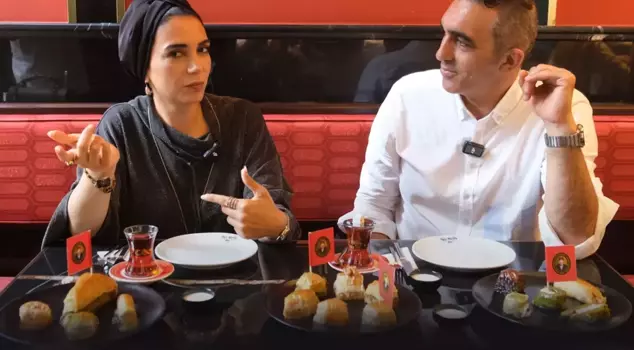
03.10.2025 15:31
In the program "Altı Üstü Lezzet" hosted by Sümeyra Teymur, Chef Reşat Aydın shared all the unknowns about baklava, from its origins and ingredients to its journey in home and palace kitchens, as well as secrets of quality.
In the new episode of the "Altı Üstü Lezzet" program, one of Turkey's most special desserts, baklava, was discussed. Host Sümeyra Teymur and guest Chef Reşat Aydın shared many details with the audience, from the historical origins of baklava to its place in palace cuisine, the importance of the ingredients used, and the number of layers. The first recipes ranging from lentils to pistachios, the differences between homemade baklava and palace baklava, and the subtleties of distinguishing quality baklava were the prominent topics of the program.
THE ORIGIN AND HISTORY OF BAKLAVA
At the beginning of the program, Sümeyra Teymur draws attention to the debates about the origins of baklava. Although there are claims of ownership from the Greeks, Arabs, and Romans, according to Chef Reşat Aydın, the main area of development for baklava is Anatolia. Reşat Aydın emphasizes that baklava is one of the most special desserts in the Ottoman palace by citing sources from Ottoman cuisine and the records of Evliya Çelebi. In this respect, baklava stands out not just as a dessert but as a historical and cultural heritage.
"BAKLAVAS IN THE PAST WERE MADE WITH LENTILS!"
Chef Reşat Aydın states that although baklava is known to be made with walnuts and pistachios today, it was made with lentils in the past. He expresses that the high protein value of lentils and the omega-3 richness of walnuts highlight the nutritional properties of baklava. Therefore, he says that baklava should be seen not only as a sweet treat but also as a nutritious food. Sümeyra Teymur adds that these details make baklava's historical journey even more interesting.
HOMEMADE BAKLAVA AND PALACE BAKLAVA
Sümeyra Teymur asks about the difference between homemade baklava and palace baklava. Reşat Aydın explains that in homemade baklava, walnuts are placed in each layer, while palace baklava gains delicacy by entering the tray with more modern techniques. He notes that baklava is the most valuable treat on Ramadan and holiday tables in palace kitchens, and the laborious preparation reinforces this special status. This difference shows that baklava has a unique place in both folk cuisine and palace cuisine.
"40 LAYERS WERE CERTIFIED IN THE PALACE"
Sümeyra Teymur raises the question, "Is real baklava 40 layers?" Reşat Aydın explains that baklava has been made with 10, 15, and 20 layers throughout history, but 40 layers were certified in the palace. He emphasizes that the quality of the flour used is as important as the number of layers. He states that especially Amasya flour, with its high gluten structure, allows the dough to be rolled out thinly, which is why baklava has reached perfection in terms of aesthetics and taste.
LOW-QUALITY INGREDIENTS DO NOT MAKE GOOD BAKLAVA
Chef Reşat Aydın states that the quality of baklava is directly related to the ingredients used. He says that real clarified butter, the right type of sugar, and quality pistachios should be used; baklava made with fake ingredients like beet sugar or peas is of low quality. He emphasizes that overly sugary syrup that burns the throat spoils good baklava, and the difference can be easily recognized on the palate. Sümeyra Teymur adds that baklava should be treated like a work of art, and it is important to pay attention to its essence rather than just its presentation.
"FLIP IT OVER AND BITE IT!"
Sümeyra Teymur brings up the rumors that baklava should be "flipped over and bitten." Reşat Aydın argues that there are no such strict rules, and baklava can be eaten in any desired way. He expresses that the important thing is to taste quality baklava made with the right ingredients. According to him, history is hidden within baklava, and the layers of flavor can be felt in every bite.
"BAKLAVA AND TURKISH COFFEE ARE THE BEST COMBINATION"
When baklava is mentioned, tea usually comes to mind, but Chef Reşat Aydın says the best pairing is coffee. He emphasizes that Turkish coffee should be consumed without sugar, and the combination of coffee and sugar creates a perfect harmony. Sümeyra Teymur notes that this is a different perspective, stating that coffee can indeed be a harmonious duo with baklava when tried together. Thus, baklava gains meaning not only as a dessert but also in the context of beverage culture.